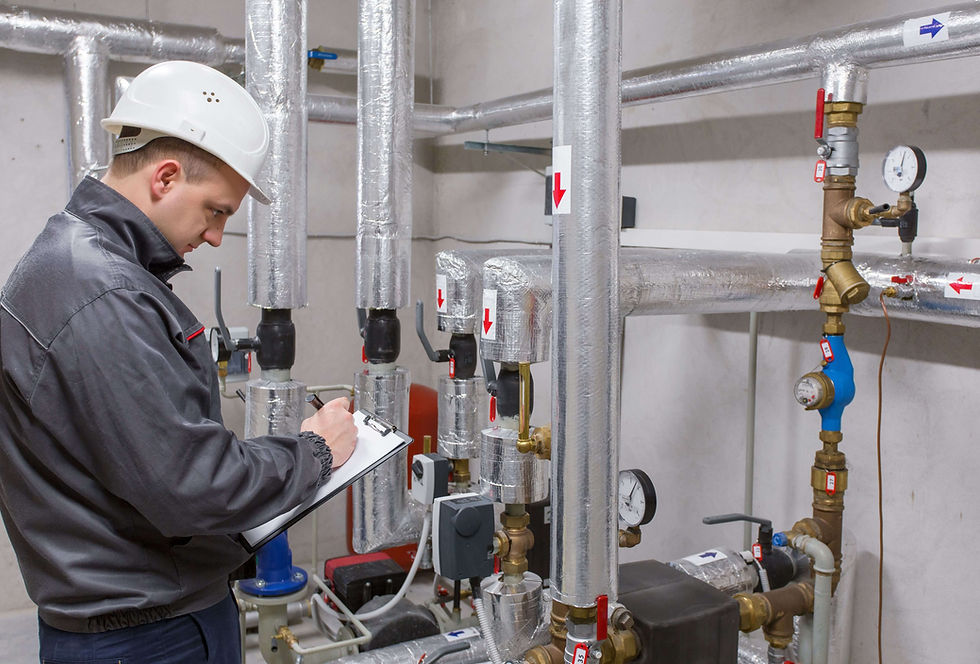Do I need a legionella risk assessment?
- Marc Fitzpatrick
- Aug 14
- 3 min read
Updated: 3 days ago

Introduction
As a facilities manager, one of your core responsibilities is keeping your building’s water systems safe, compliant, and free from harmful bacteria. Legionella is one such risk. It can cause serious illness, including Legionnaires’ disease, if left unmanaged.
If your premises include any water systems, you are legally required to carry out a legionella risk assessment in line with the Health and Safety Executive’s (HSE) Approved Code of Practice (ACoP L8). This assessment isn’t just a legal tick-box—it’s an essential part of protecting people’s health and demonstrating responsible management.
What is a legionella risk assessment and why is it needed?
Understanding Legionnaires’ disease
Legionnaires’ disease is a severe form of pneumonia caused by inhaling water droplets contaminated with Legionella bacteria. These droplets can come from everyday systems such as showers, taps, cooling towers, humidifiers, and spa pools. The bacteria thrive in certain conditions—particularly stagnant water between 20 °C and 50 °C.
Your legal duty as a duty holder
If you control premises—whether as an employer, landlord, or facilities manager—you have a legal duty under the Health and Safety at Work Act 1974, COSHH 2002, and HSE’s ACoP L8 to manage the risk from legionella. This starts with a suitable and sufficient legionella risk assessment carried out by a competent person.
Clear answer to the question
Yes—you need a legionella risk assessment if:
Your building has a hot or cold water system
There is potential for water to be stored or recirculated
Water temperatures could encourage bacterial growth
The system can release droplets into the air
Even “low-risk” systems require a documented assessment.
What does a legionella risk assessment involve?
Identifying hazards in your water systems
A professional assessment will map your entire water system, including storage tanks, pipework, outlets, and any equipment that can generate aerosols. It looks for risk factors like dead-legs in pipework, poor insulation, stagnant areas, or temperature control issues.
Evaluating risk and recommending control measures
Each hazard is assessed for likelihood and impact. Control measures might include:
Regular flushing of infrequently used outlets
Biocide dosing
Removing redundant pipework
The outcome is a written risk assessment report with a practical action plan.
Monitoring, review, and record-keeping
The HSE’s technical guidance HSG 274 recommends reviewing your risk assessment at least annually, or sooner if:
The building layout or water system changes
There’s new equipment or usage patterns
Test results show contamination
All checks, maintenance, and corrective actions should be logged and accessible.
Risks of ignoring a legionella risk assessment
Legal and financial consequences
Failing to comply with ACoP L8 and COSHH can lead to enforcement action, significant fines, or prosecution - especially if an outbreak occurs. Courts have handed out six-figure penalties to organisations that failed to manage the risk.
Health and safety impact
An outbreak can put employees, residents, tenants, and visitors at serious risk. Legionella prevention measures aren’t just about avoiding fines—they are about safeguarding lives.
Reputational damage and operational disruption
A confirmed case of Legionnaires’ disease linked to your premises can severely damage trust. Investigations, system shutdowns, and media coverage can cause long-term harm to your organisation’s reputation.
How often should a legionella risk assessment be carried out?
Routine review
For most facilities, an annual review is good practice. However, the risk assessment should be updated immediately if there’s any change to the water system, its use, or building occupancy.
Triggers for reassessment
You should also commission a new assessment if:
There’s a suspected or confirmed case of Legionnaires’ disease
Monitoring results fall outside control limits
Major building works affect the water system
Keeping compliance simple
By embedding legionella risk management into your facilities maintenance compliance processes, you can ensure reviews are carried out without disrupting operations.
Frequently asked questions
Who can carry out a legionella risk assessment?
It must be done by someone competent—this could be an in-house professional with appropriate training or an external specialist with UKAS accreditation or membership in the Legionella Control Association.
Do small buildings need an legionella risk assessment?
Yes. Even small offices or simple systems can present risk, particularly if water is stored or recirculated.
Is water testing always required?
Not always. Sampling is typically needed if there’s reason to suspect contamination, or as part of ongoing verification that control measures are working.
Next steps for facilities managers
If you haven’t had a legionella risk assessment in the past 12 months, now is the time to review your compliance. You can learn more about related systems on our website:
For practical guidance on remedial actions after an assessment, visit our Legionella Remedial Works page.
Final word: Carrying out and regularly updating your legionella risk assessment isn’t just a regulatory requirement - it’s a straightforward, practical step that keeps people safe, protects your organisation’s reputation, and ensures you meet your legal duties.










